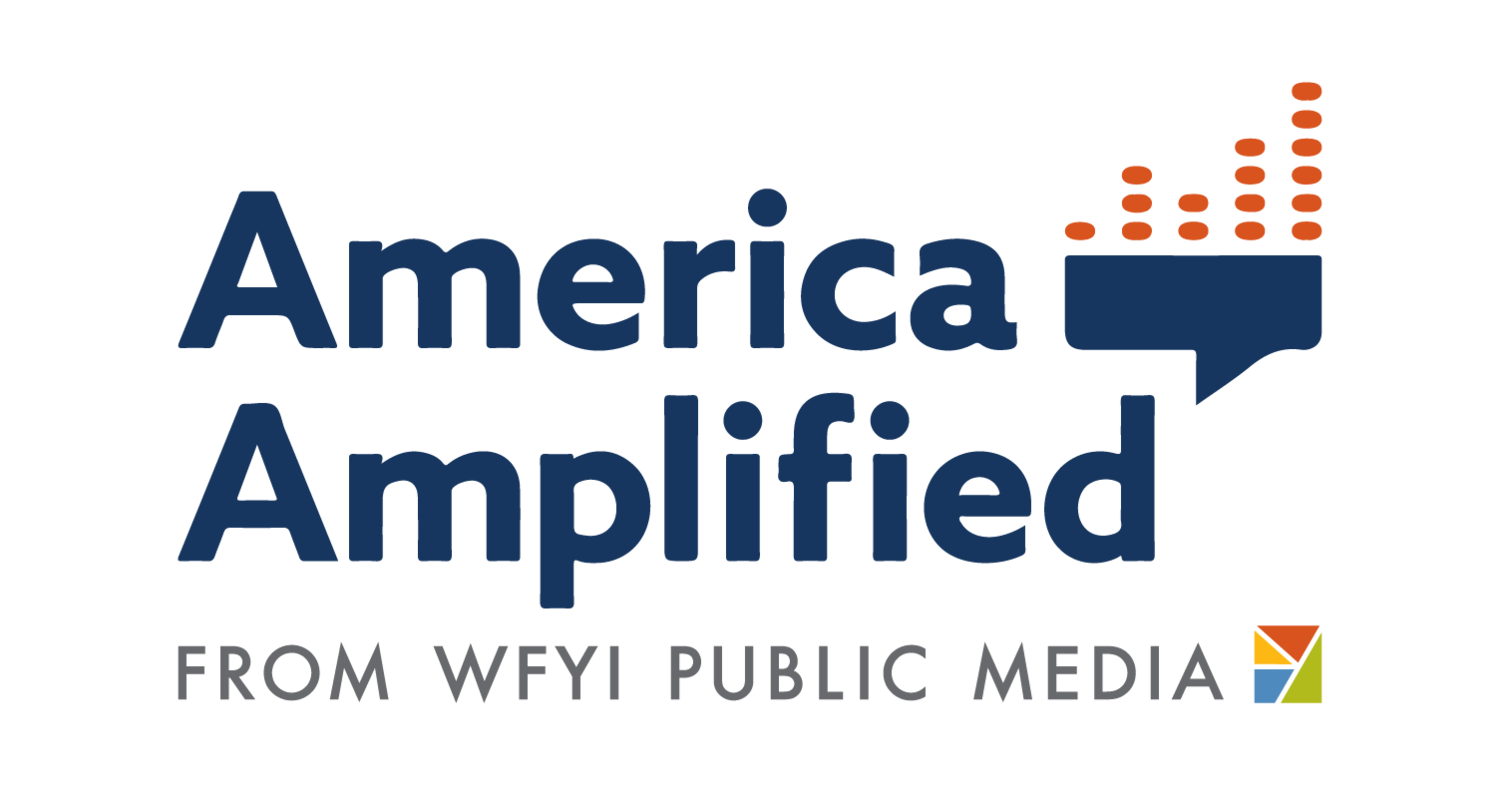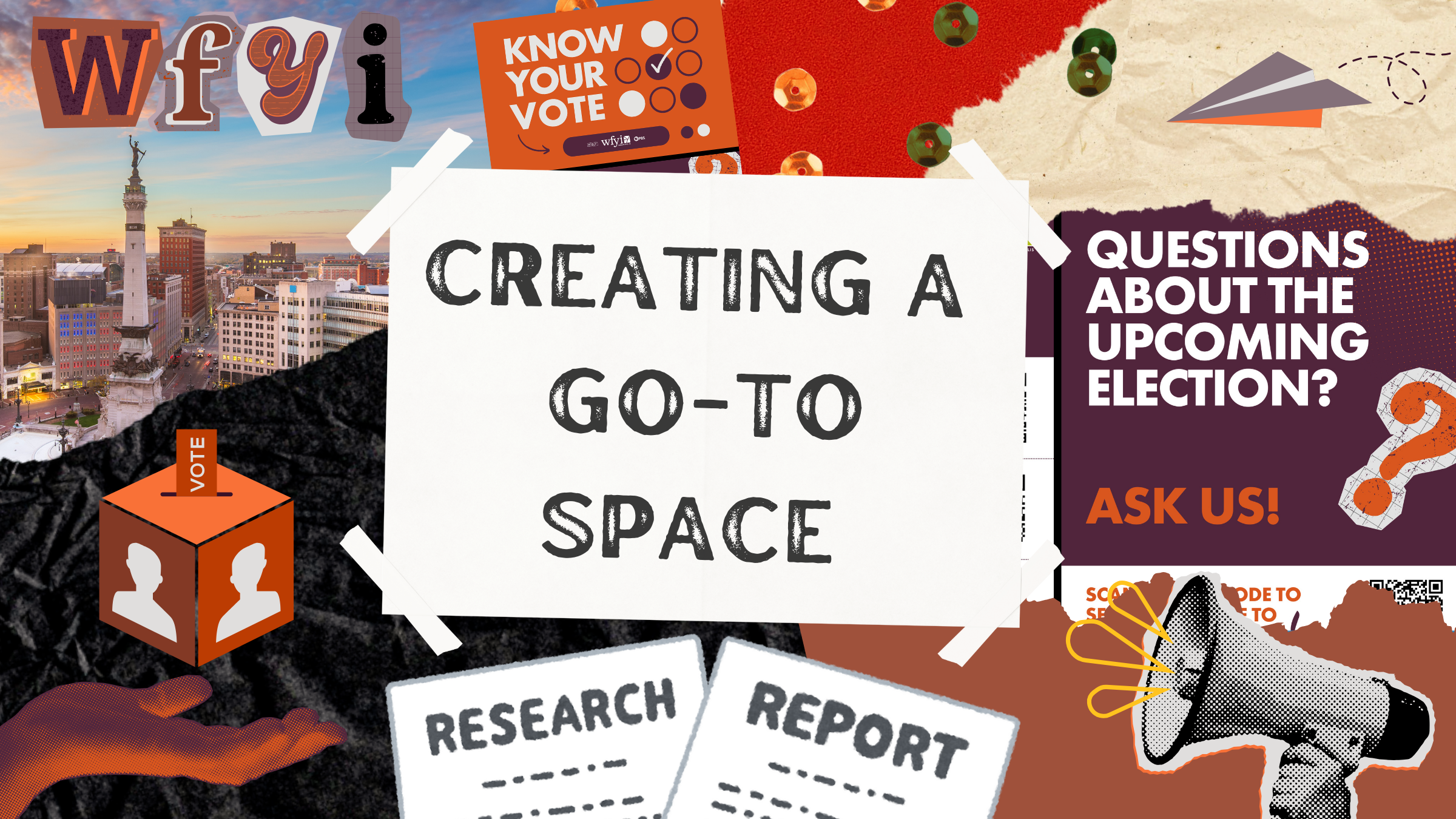For Election 2024: WFYI in Indianapolis created a space where people go
Photo: Collage by Kateleigh Drumm / America Amplified
Listening sessions and a comprehensive voter guide for Central Indiana helped WFYI combat low voter turnout
WFYI in Indianapolis launched a project this election season to produce, for the first time, a comprehensive guide for central Indiana. The voter guide included information about candidates for nearly 50 federal and state races, as well as information on 12 school board races and 3 school district referenda. Many public media stations take on ambitious voter guide projects, especially for major elections. But this was the first time WFYI reached this far and the first time that they began the election project with a plan for their newsroom to collaborate across the content department and incorporate broad-based listening across their coverage communities. The result: Some of the highest-performing election content that WFYI has ever seen.
In addition to reporting, designing, writing and producing the digital Voter Guide, WFYI developed a distribution strategy for the guide and other voting and election-related information that prioritized reaching new communities. They produced a series of 15 informative Instagram reels on election topics, and designed and printed 25,000 flyers with QR codes that either linked to basic voting information or to the comprehensive digital Voter Guide.
As another key part of the station's community engagement efforts, reporters and editors held a number of listening sessions leading up to the election, taking questions and comments at the public library and other gathering spots. And the newsroom's education desk hosted two candidate forums for high-interest school board races. WFYI wanted to address the problem of low voter turnout in Indiana, but also prioritized reaching young people, as well as audiences who wouldn’t normally be visiting their website or drawn to their coverage.
America Amplified talked to News Director Sarah Neal-Estes and to Managing Digital Editor Drew Daudelin to understand the project’s objectives and learnings.
The Objective:
Neal-Estes: Overall I had two main goals: The first one was to get more people in our communities the information they valued and needed and could really use. The second goal was internal: I wanted to see if we could do engagement more collaboratively throughout the content department, to improve our practices and to do them deliberately together to form better habits for the future. I wanted to create better habits of consistent communication internally, with coordinated direction from myself and Gail Strong, WFYI’s Vice President for Community Engagement and an America Amplified Advisory Board member.
Daudelin: The voter guide and the Instagram video project were two huge efforts we wanted to do because we hadn’t done that much around elections in the past and I wanted to see what we were capable of. We came up with a plan that was more than we could do and we did as much as possible. The voter guide ended up being a nice resource where audiences could very clearly see who was on the ballot and what their stances were. We created a one-stop shop for all of our election stuff.
There was also an educational piece, with vertical short-form videos for social media — 15 videos distributed across all our active social media platforms on subjects like why school board elections matter and vaccine misperceptions. Because voter turnout is not great in Indiana we have to get people basic information to understand what's going on, basic civic education to help voter turnout. We wanted to focus on those basics and to make good, educational, easy-to-watch videos, under two minutes in length. People are overwhelmed and exhausted; making fun, accessible, engaging, quick videos can reach them. Also, I wanted [the newsroom] to get better at making videos. The election period was a nice space to get everyone involved creating these videos for social media platforms.
Indiana School Board candidate forum, hosted by WFYI's Education desk. Photo by Eric Weddle.
The Challenge
For Neal-Estes and Daudelin there were two levels of challenges: “First, there’s a ton of information out there and we had to figure out how to present it clearly. How do we maximize the accessibility of the stuff we are making to try to get as many people as possible to look at it?”
The second challenge was overcoming the silos that separate community engagement efforts from newsroom editorial decisions and content. For Daudelin, the listening projects were not as successful in contributing to the Voter Guide as they could have been. “The [listening sessions] dragged on for a long time; there were lots of people involved and a lot of meetings, but not a lot of clarity about how to use what we learned from listening.” The questions posed to candidates in the voter guide were informed by listening sessions, and through the use of Hearken and on-the-ground reporting, but they represented broad topics — the economy, inflation, etc. — not specific questions from specific voters. For Daudelin, that would be a goal for a future voter guide.
The Solution
Neal-Estes felt the listening sessions were useful: “You don’t have to have a goal about how to use [the listening]; just be open to finding new information that you didn’t know about. I believe the broader listening helped us do that. While many [in the newsroom] still want to know the plan first, before the listening. What I’m saying is, ‘We can listen because we know there is a story, and we can listen to find something off our radar. Can we please have both? Yes, and…?’”
Daudelin says he was originally scared no one would look at the guide. Instead, metrics for engagement and reach were impressive: Web traffic for news stories on Election Day 2024 was nearly 65,000, compared to about 20,000 on Election Day in 2020. That’s a 230% increase.
Using old-fashioned flyers to promote the voter guide allowed the station to reach audiences that would never have come to the website on their own. And the social media videos were a huge success as well. Newsroom staff is much more educated on how to make high quality videos, and “while it is hard to gauge social numbers, we’ve seen pretty crazy growth on social platforms since we started doing videos.”
Daudelin pointed to one concrete example of engagement: “You notice little things tied to this stuff. We did a static digital post when the governor’s race was over. It was just a picture saying he won. There were about 170 comments on the post; people talking back and forth, commenting to each other. That never happened in the past. We had created a place to congregate. It was a nice indication that all the work we’re doing is creating a space where people go. That is the entire goal.”
WFYI’s team created postcards with QR codes and dispersed them to get information out about their comprehensive voter guide.
These postcards helped connect people to WFYIs reporting and helped get new information and questions in from the public.
The Takeaways
Neal-Estes:
Start early! We didn’t and were playing catch up the whole time.
Share engagement activities across the newsroom to help unite efforts and communication and set priorities faster and easier.
Use community engagement on a regular basis in non-election years, and always learn more about what communities want elected officials to know.
Daudelin:
Come up with a specific and concrete plan about how to use community engagement as well as audience feedback and questions, and commit to it.
Use other departments to help get the word out about resources and content that you are creating. For the voter guide, it was a huge success for us to collaborate with marketing on ads, billboards, and paid promotion on social media.




